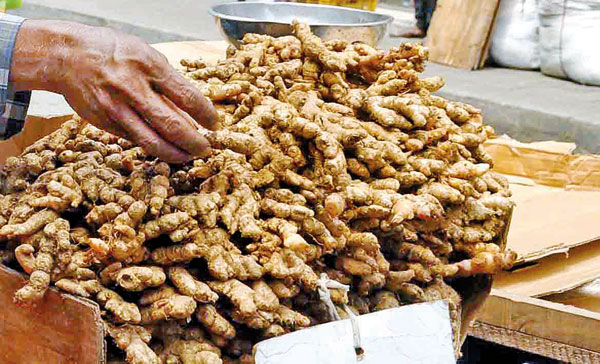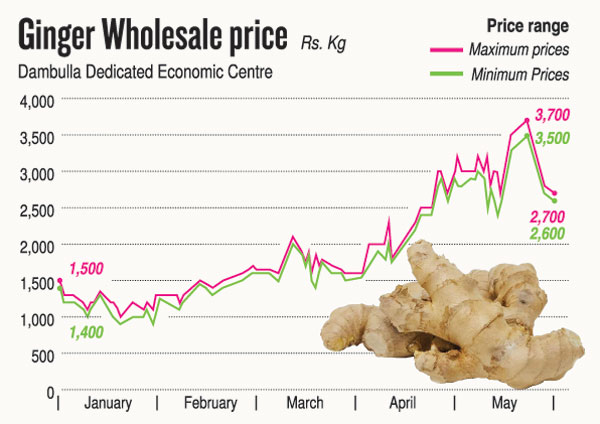News
Ginger prices hit Rs. 5,000 a kilo, drawing pungent criticism; ministry faces import dilemma
View(s):By Niranjala Ariyawansha
The average person’s cup of tea now lacks the once-familiar zing of ginger, and the tempting taste and aroma that ginger adds to curries are absent in many homes. The reason is the steep rise in the cost of this popular herbal spice. It has soared to an unprecedented high of Rs. 5,000 a kilogram.
With ginger prices skyrocketing, the authorities are mulling the import of about 2000 metric tonnes of ginger to stabilise prices, the Sunday Times learns.
Agriculture Minister Mahinda Amaraweera said the soaring prices were the result of import restrictions during the past several years.
But the decision to import ginger is beset with a dilemma. The minister said if the prices dropped due to imports, local farmers would be discouraged from growing ginger.

With ginger prices skyrocketing, the authorities are mulling the import of about 2000 metric tonnes. Pic by Priyanka Samaraweera
“When the price drops, farmers do not cultivate ginger. When there is less cultivation, prices increase. This is very difficult to control,” he said.
An official of the Department of Minor Export Crops (DMEC) said that whatever the explanations for the price hike, the ground reality is that there is not enough ginger to meet the local demand.
Expressing displeasure over the need to import ginger, a crop that can be easily grown domestically, he attributed the high prices and reliance on imports to the authorities’ failure to guide farmers on cultivation timing.
“This is negligence. If farmers had been informed at the proper time that the required quantity of ginger is so much and raised awareness about obtaining such a harvest, the price of ginger would not have reached as high as Rs. 5,000,” he noted.
DMEC officials pointed out that the farm gate price of ginger remained at about Rs. 2,800, but intermediate traders manipulated the market to increase the price.
The retail price of ginger has been steadily increasing in recent months, with consumers now having to pay over Rs. 480 for 100 grams—not an affordable price for the average consumer, who previously purchased ginger for under Rs. 1,000 per kilogram.
DMEC Director General A.P.P. Disna explained that the price of ginger rose to Rs. 1000–1500 in the 2021–22 period, leading to early harvesting in November and December. This early release to the market was a result of increased demand and higher prices.
“The price of ginger in the country was initially low, causing farmers to stop cultivating it. However, in 2021, the price increased significantly, motivating farmers to start growing ginger again. This led to an increase in the theft of cultivated ginger. To combat this issue, harvesting was done in November and December 2023, while the crop was immature. As a result, ginger is currently not being received in the market,” she explained.

According to her, farmers have now begun cultivating ginger again.
Ginger is a profitable trade crop that thrives in various regions across Sri Lanka, especially in wet and intermediate zones such as Kurunegala, Gampaha, Colombo, Kegalle, Anuradhapura, and Kandy districts. Cultivation typically takes place in March and April, with a harvest ready after nine months. Therefore, the harvest is likely to reach the market after December.
The annual ginger consumption in the country is about 18,000 metric tonnes. The DMEC said that most of the locally produced ginger is for domestic consumption. A small quantity is exported, and in 2020, 110 metric tonnes were exported to European countries such as Britain.
As the Economic Research Unit of the DMEC points out, local ginger has the shape of small fingers, and its quality is high. However, recently, large-sized ginger has been seen in the markets.
According to the DMEC, the export of overall minor crops in 2023 was 58,190 metric tonnes. This included 128.5 MT of raw ginger and 2.03 MT of ginger oil.
Locally produced ginger is used for daily domestic consumption, pharmaceuticals, and confectionaries that make ginger beer and biscuits.
In 2022, the DMEC’s Economic Research Unit found that 2,817 hectares of land were used to cultivate ginger, yielding 25,000 MT, surpassing annual needs. In 2023, about 2,380 hectares produced 19,375 MT of ginger. The median annual land use for ginger cultivation was 2,300 hectares, showing self-sufficiency in recent years. Sri Lanka’s ginger production had met or exceeded demand, ensuring a stable supply for consumption.
To encourage the cultivation of local minor export crops, the government on August 17, 2020, issued an extraordinary gazette notification 2189/4, restricting the import of minor export crops. It is in effect even at present.
Consumer rights activists say an agriculture product should be cultivated according to the annual requirement and its stocks maintained while ensuring consumers are granted the opportunity to obtain those products at an affordable price, and it is the responsibility of officials.
If the price of a product is determined according to economics, someone can argue whether a government is needed for a country, the activists say.
The best way to say that you found the home of your dreams is by finding it on Hitad.lk. We have listings for apartments for sale or rent in Sri Lanka, no matter what locale you're looking for! Whether you live in Colombo, Galle, Kandy, Matara, Jaffna and more - we've got them all!

